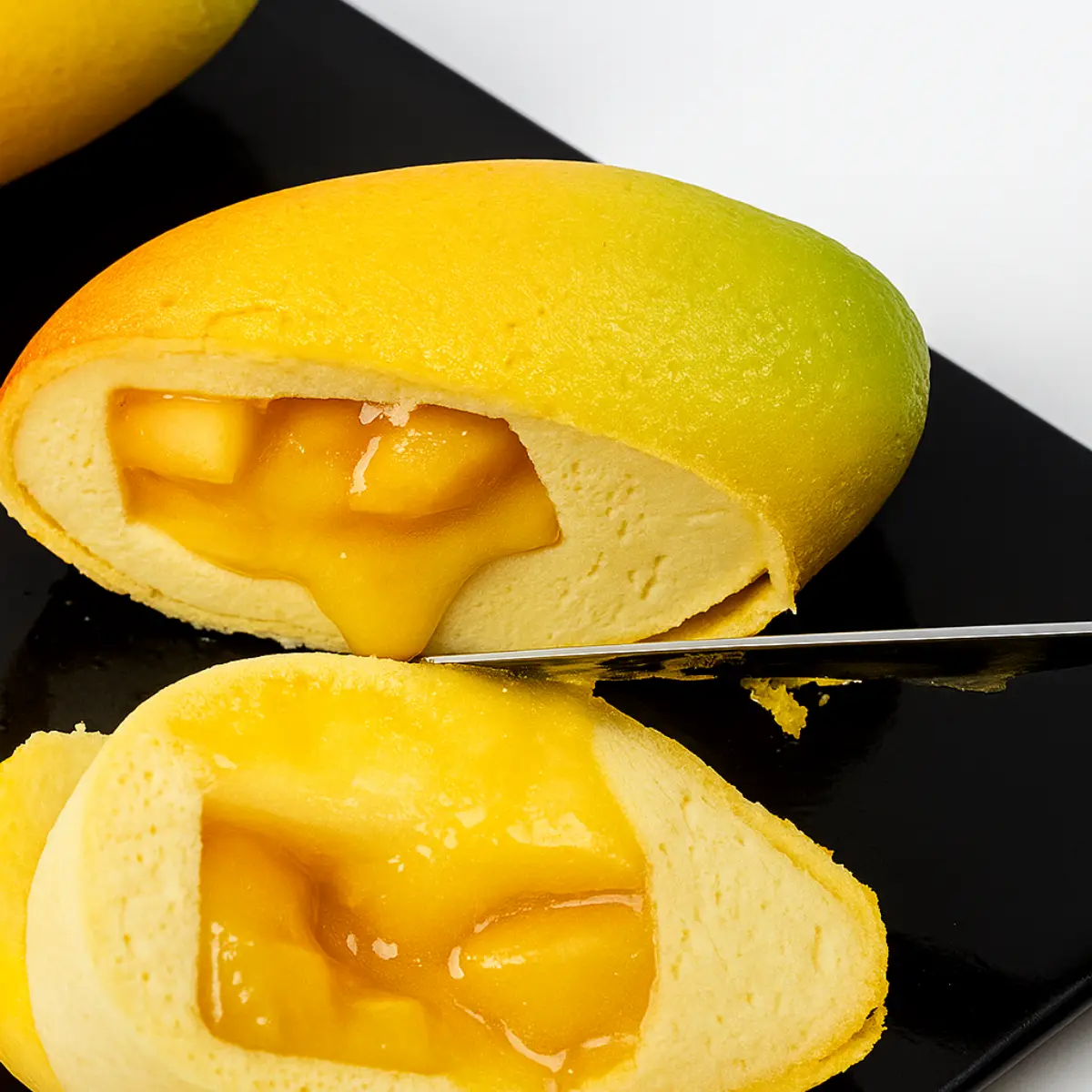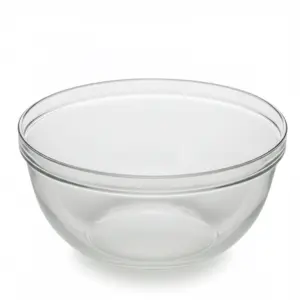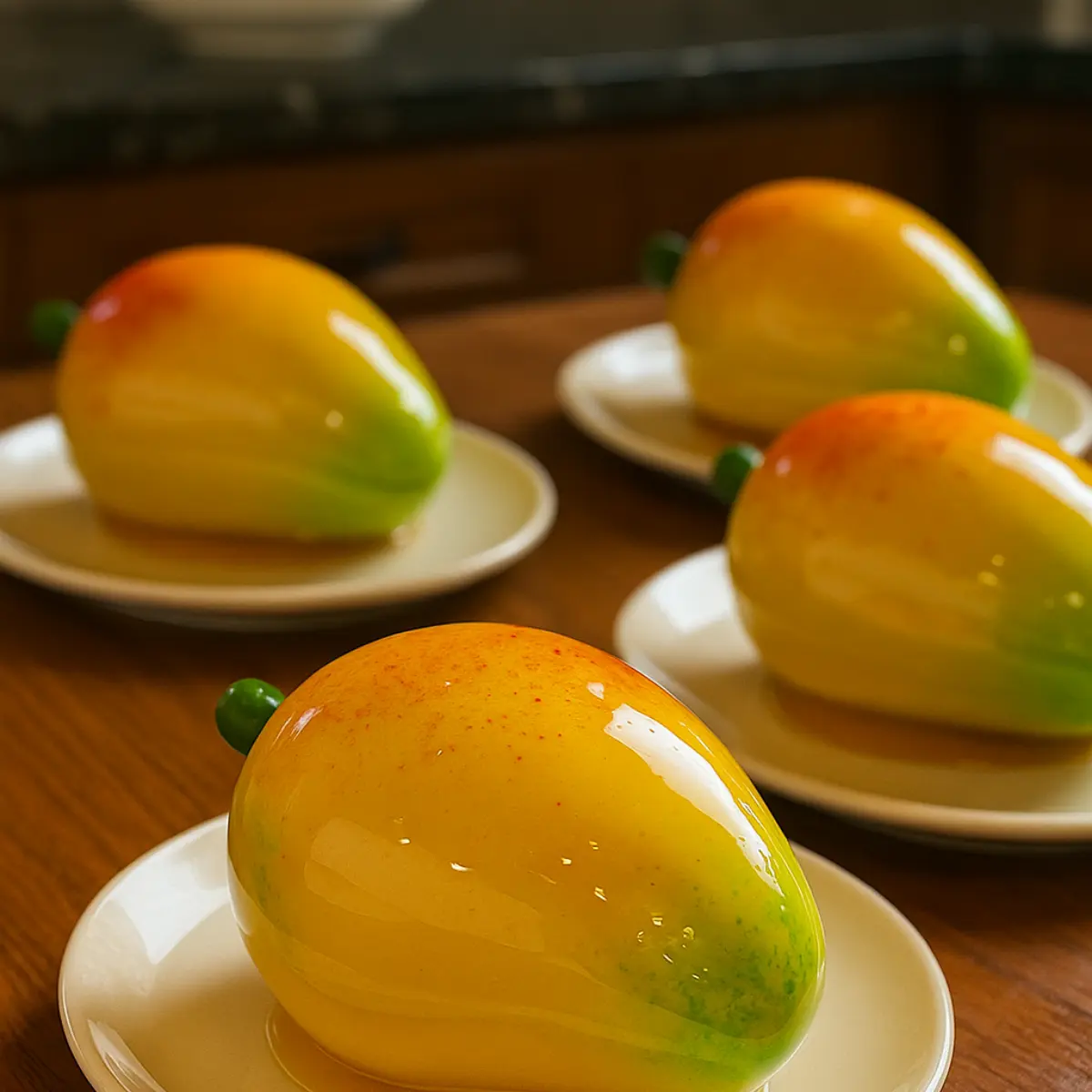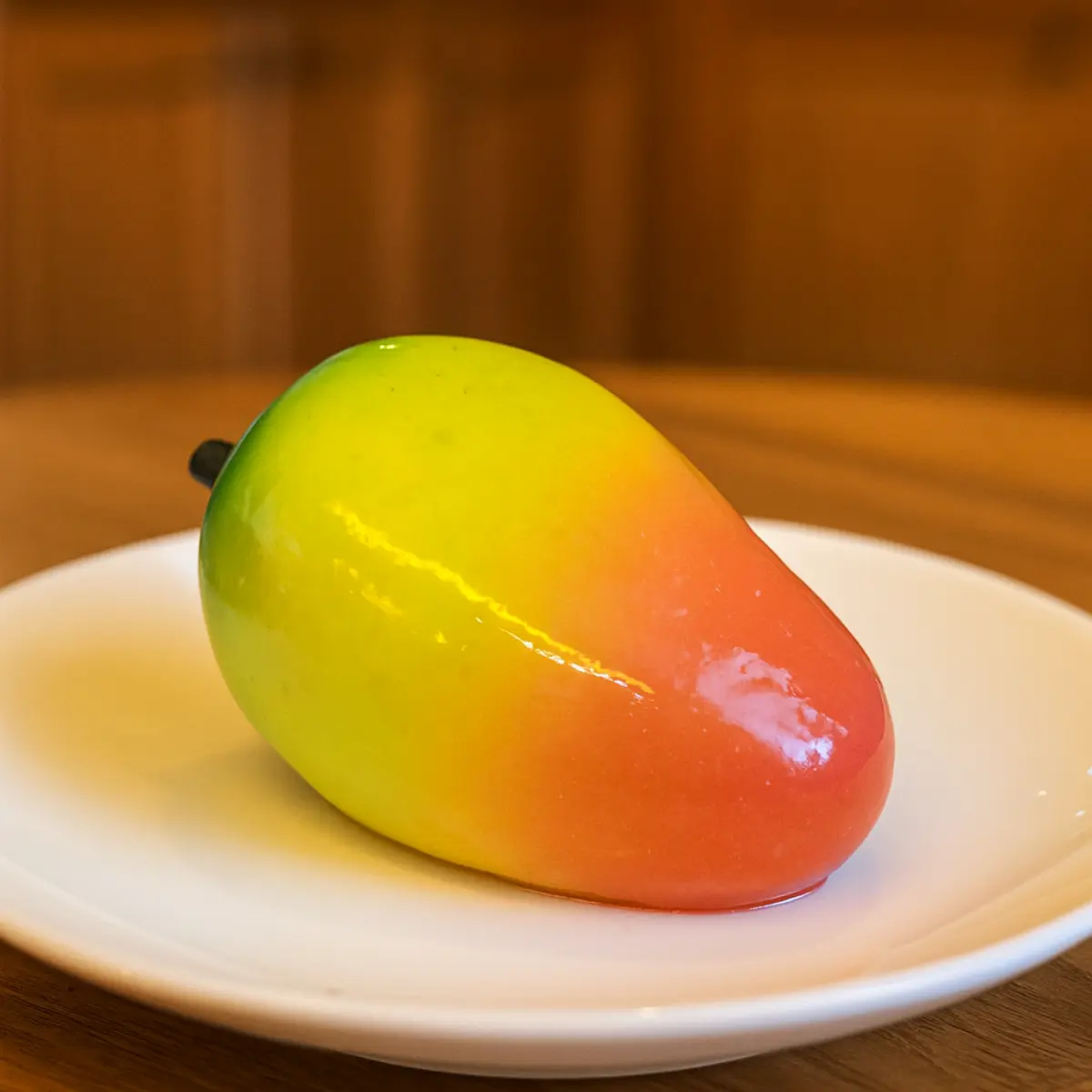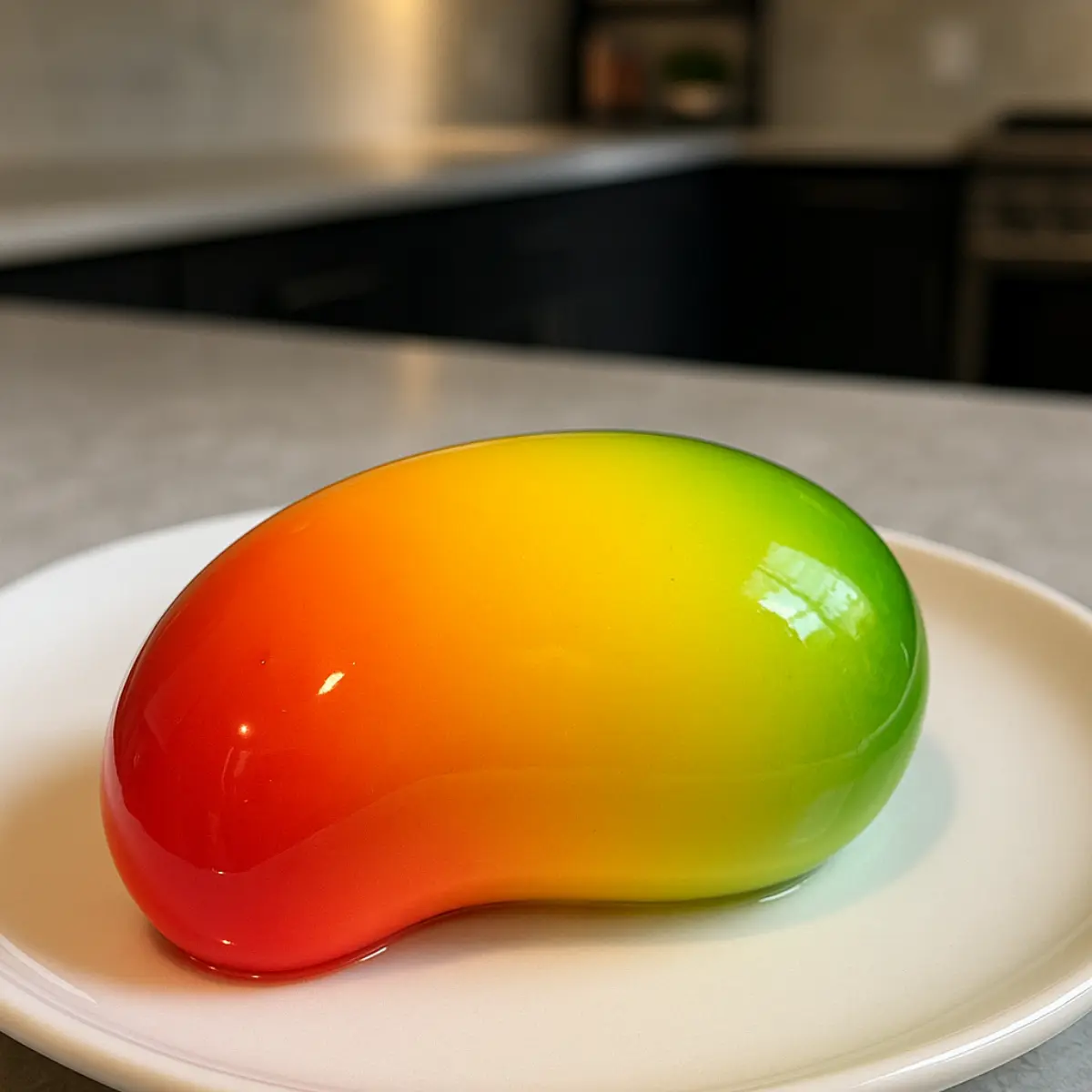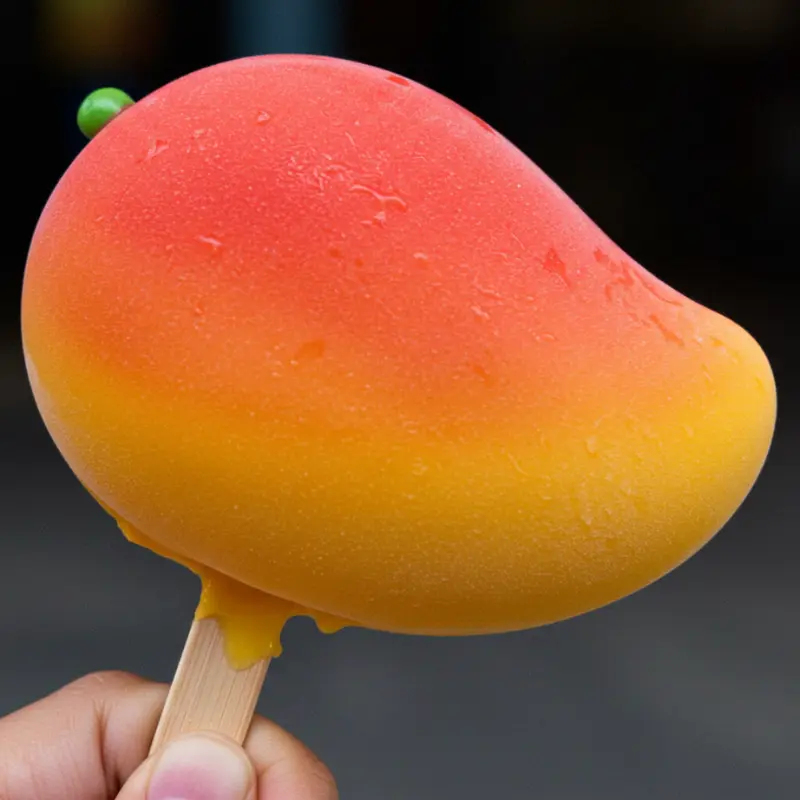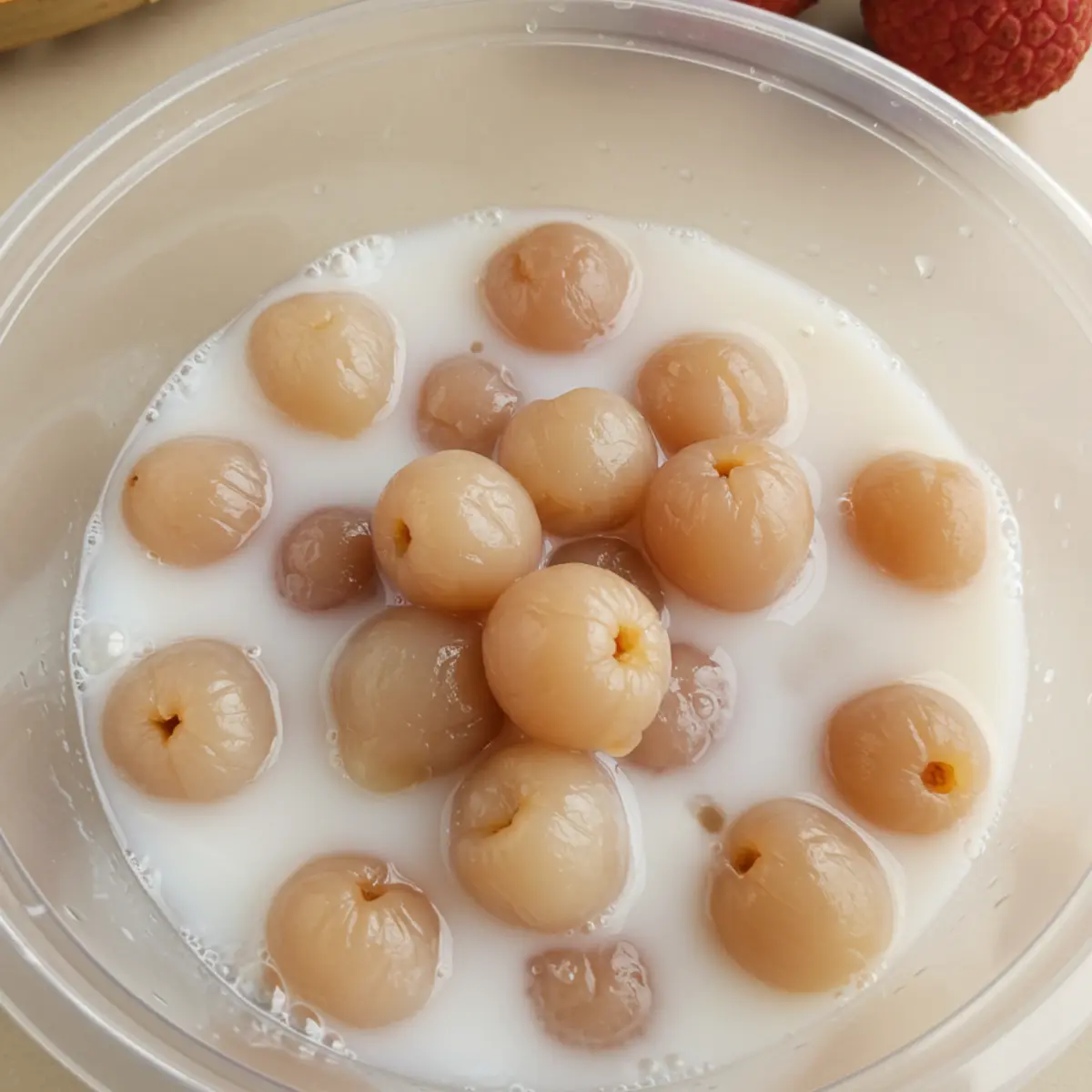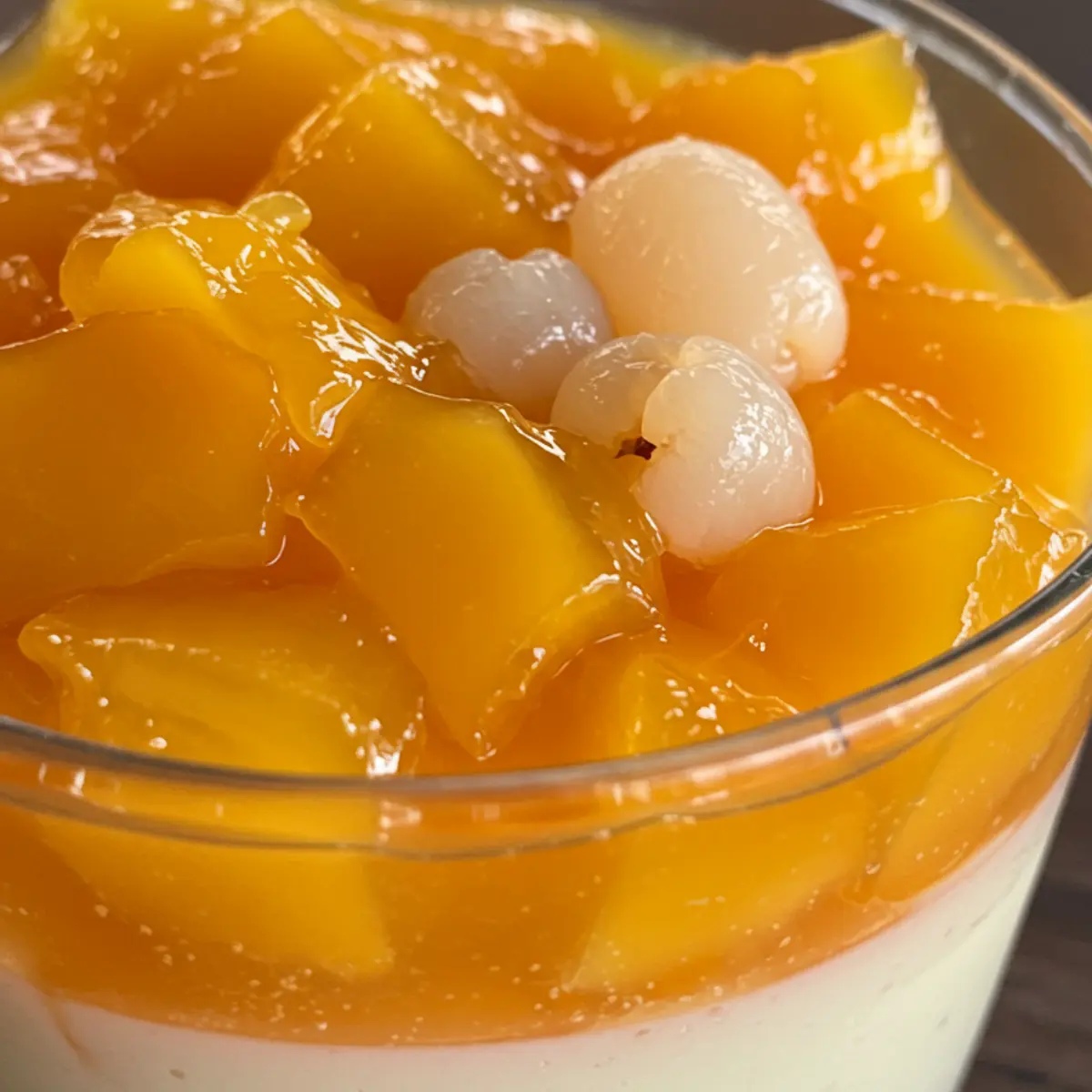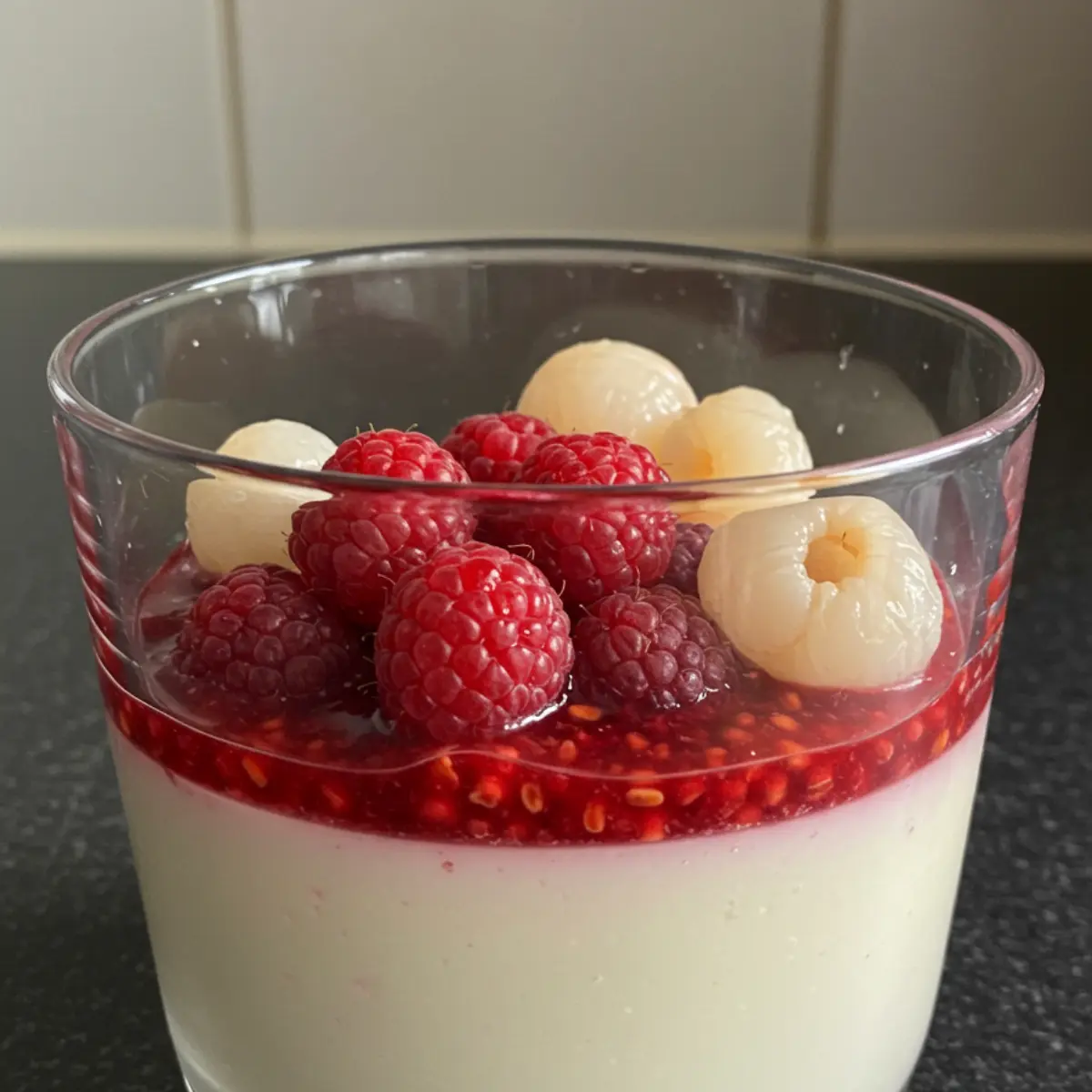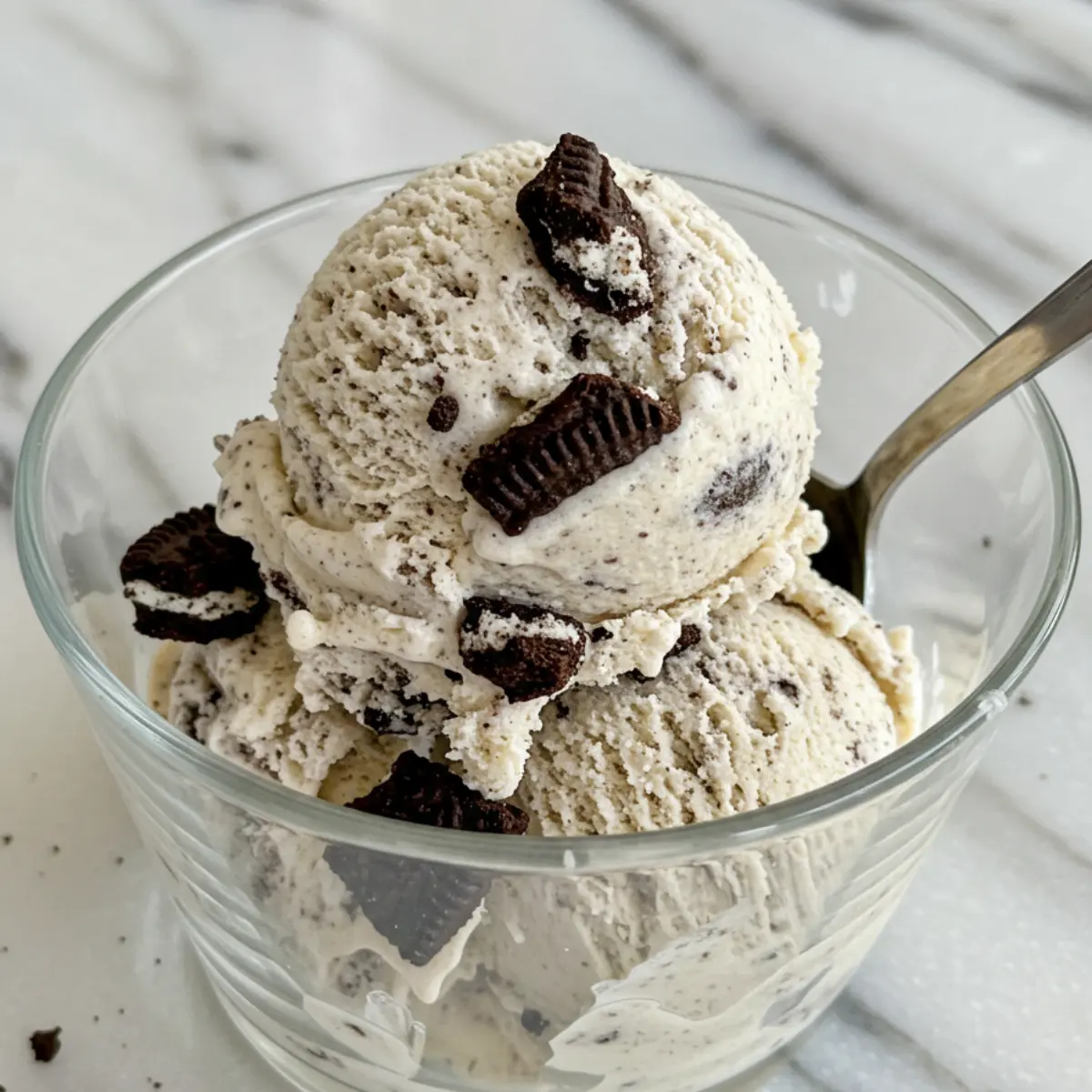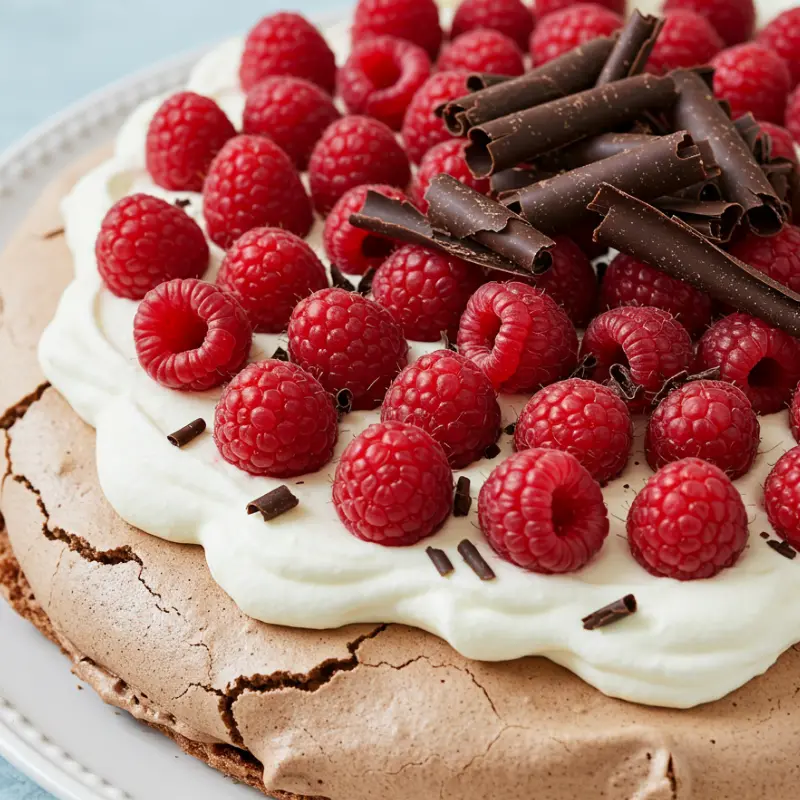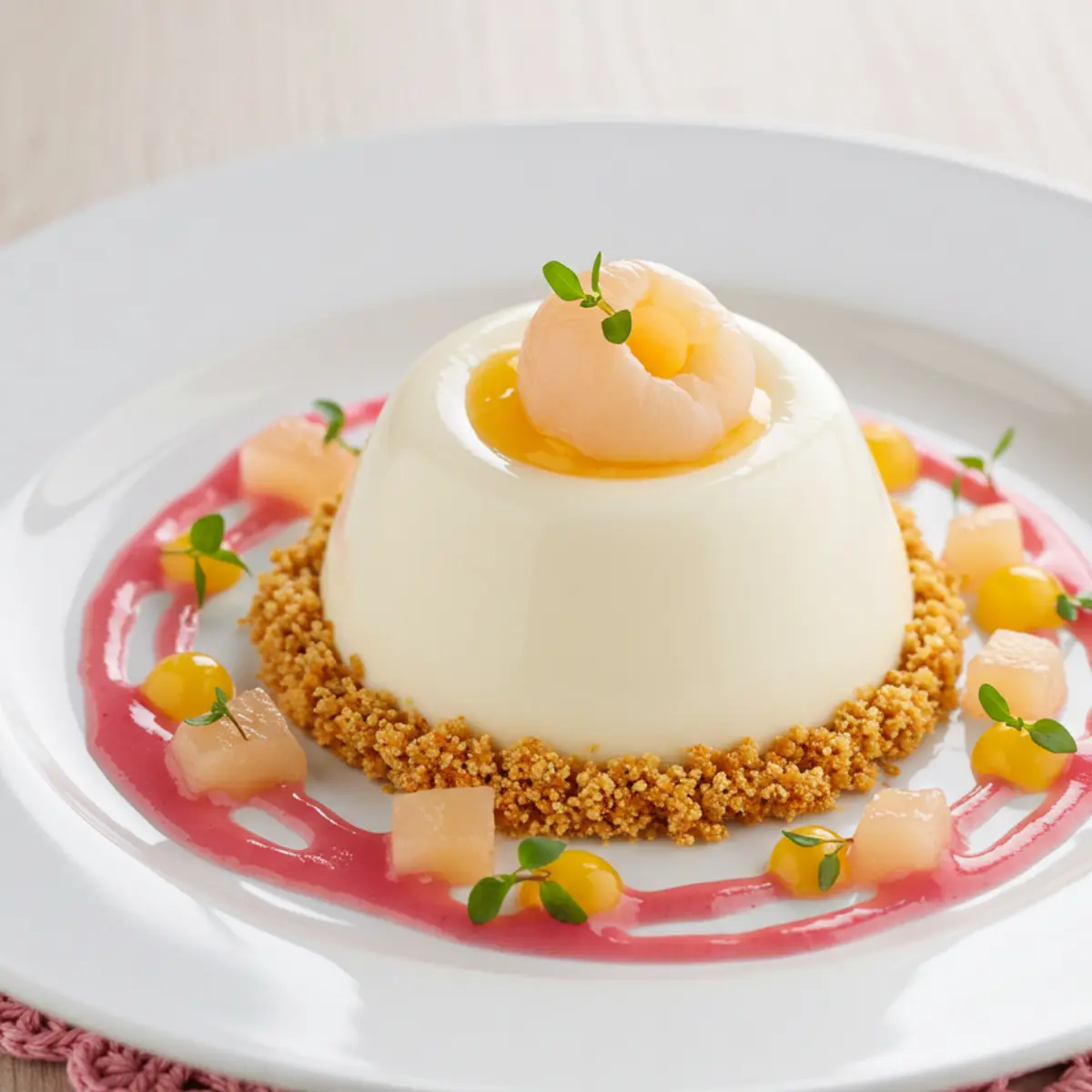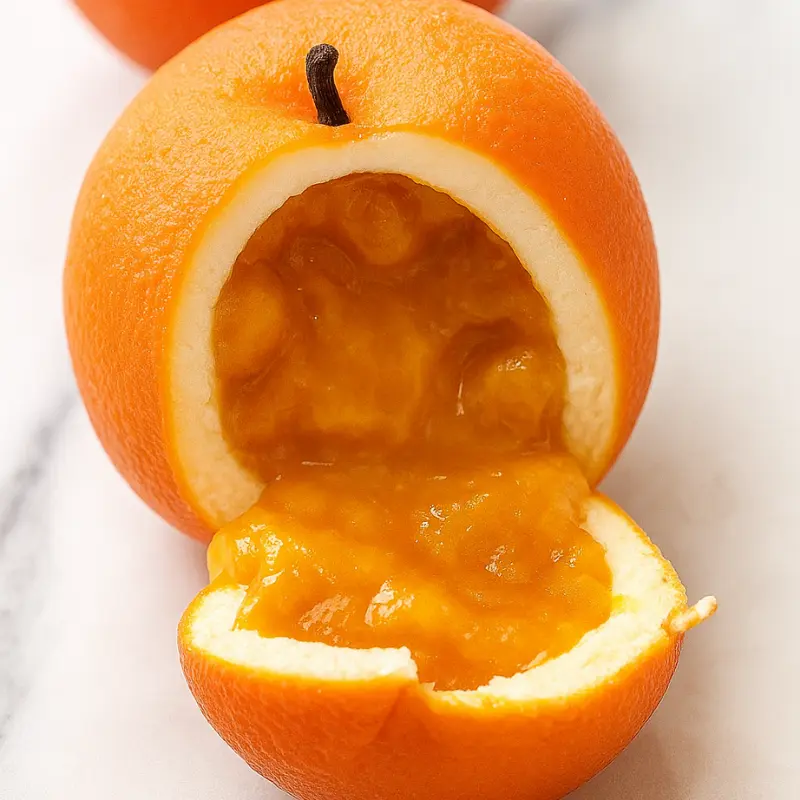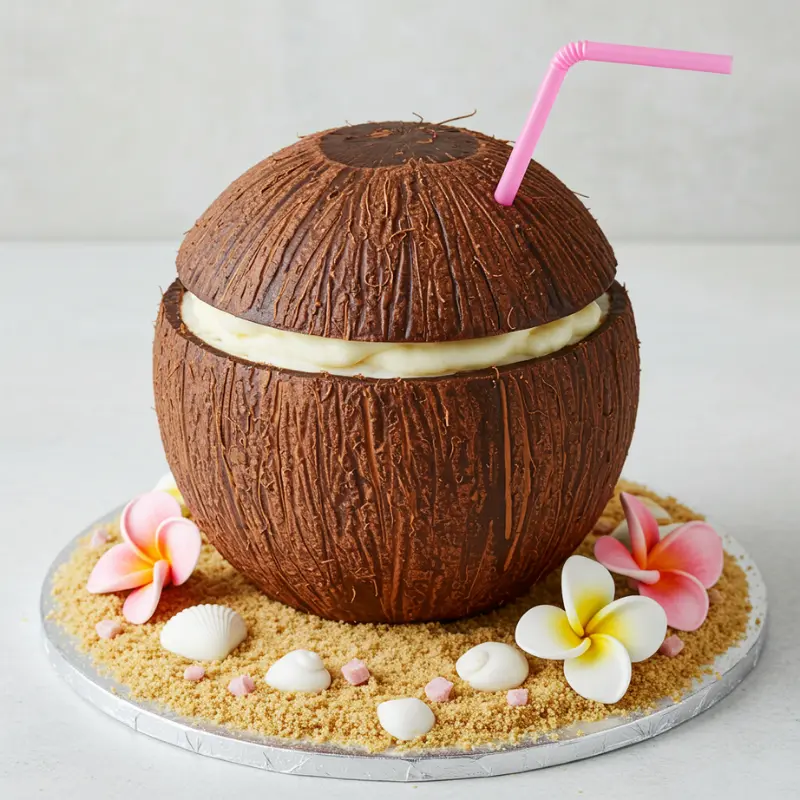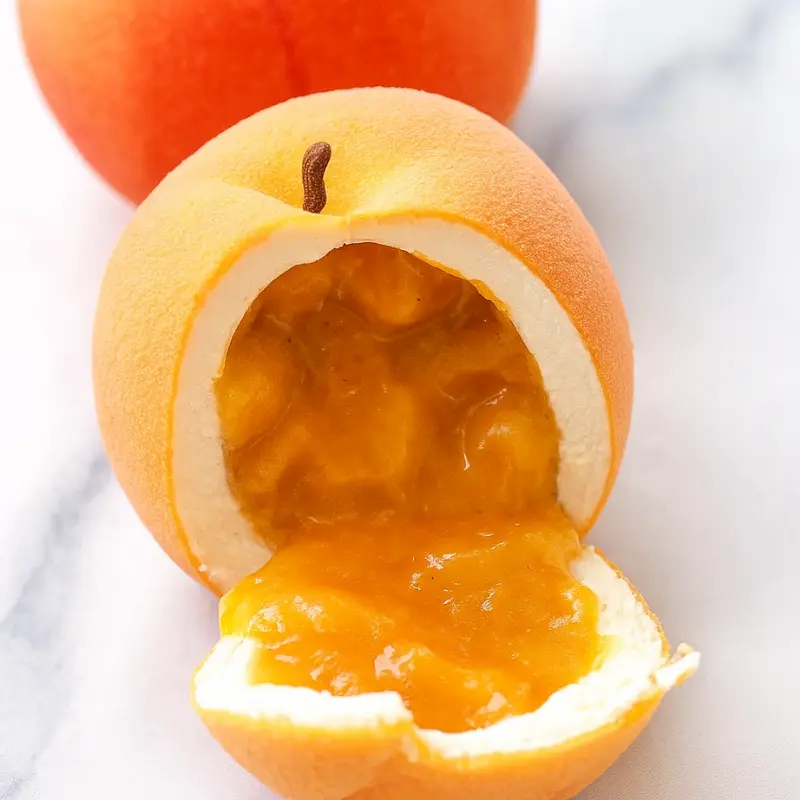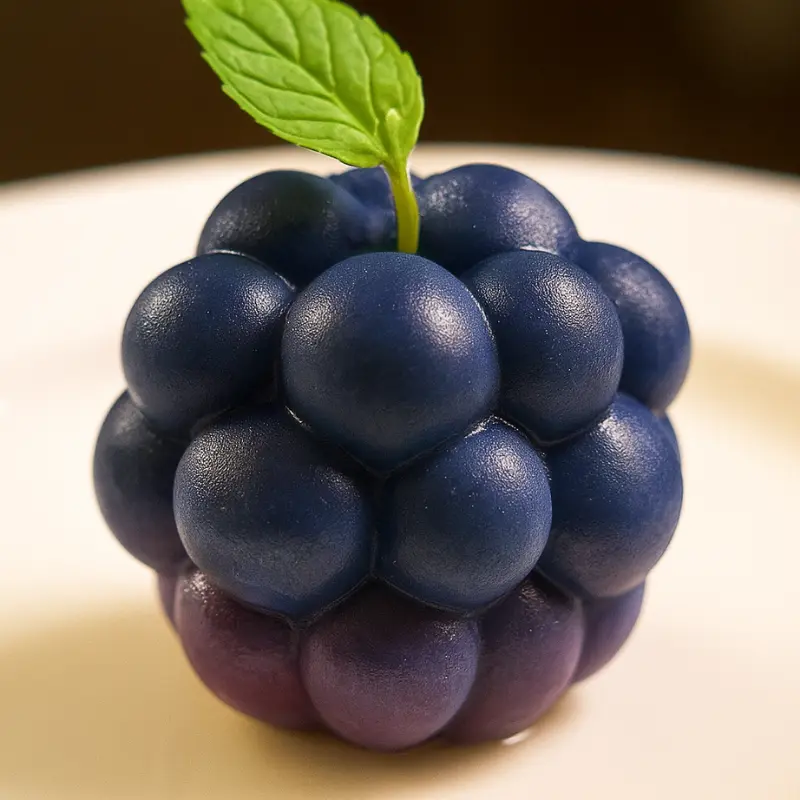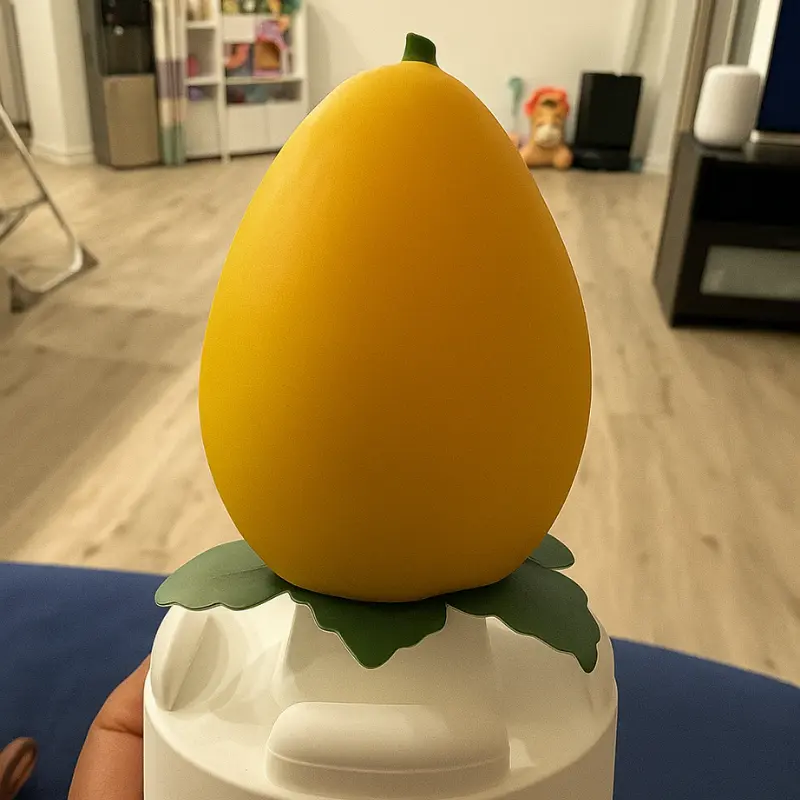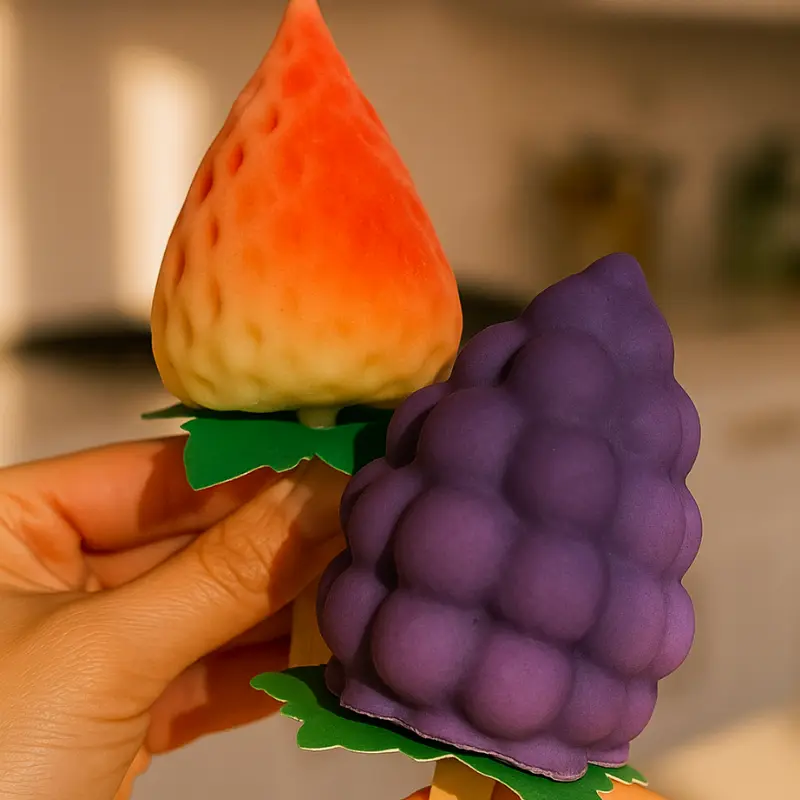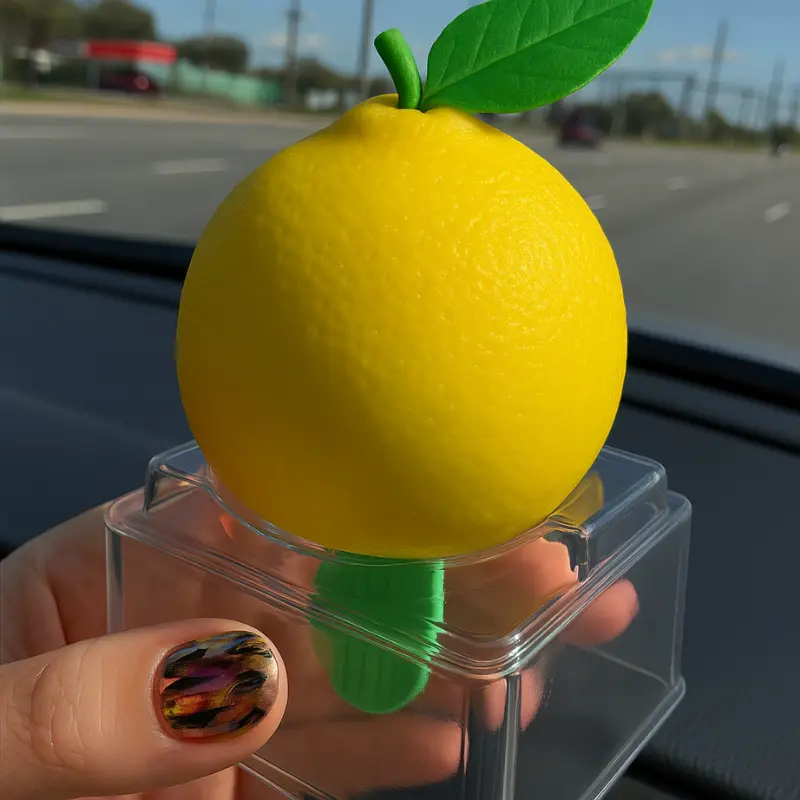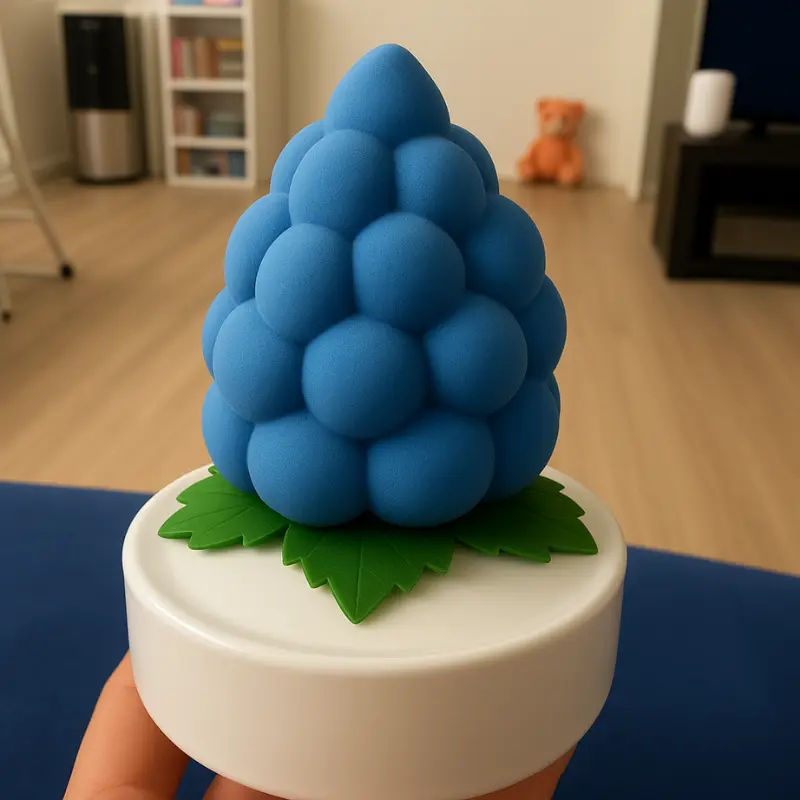Japanese mango mousse cake combines the tropical goodness of mango with the elegance of Japanese patisserie. It’s light, smooth, and almost too pretty to cut into. Almost.
This step-by-step guide walks you through making Japanese mango mousse cake with gelatin, along with no-bake options for days when you want something easy but impressive. Get ready to whip up a dessert that tastes as good as it looks.
Jump To:
Chef-Quality Tools You Need
Japanese Mango Mousse Cake That Will Wow Everyone
A luxurious Japanese mango mousse cake shaped like a real mango, featuring a tangy mango marmalade insert, creamy mango-infused white chocolate ganache, and a smooth velvet coating for a stunning summer dessert.
- Total Time: 12 hours
- Yield: 6 servings 1x
Ingredients
For the Mango Marmalade Insert:
300 g fresh ripe mangoes, peeled and diced
200 g mango purée
1 tsp lemon juice
50 g sugar
5 g pectin
1 tsp mango liqueur (optional)
For the Mango Ganache Mousse:
200 g mango purée
100 ml heavy cream (heated for infusion)
5–6 fresh lemon verbena leaves
200 g white chocolate, chopped
6 g gelatin sheets, softened
200 ml chilled heavy cream
1 tsp mango liqueur (optional)
For Coating:
150 g white chocolate
150 g cocoa butter
Yellow and green cocoa butter spray
Instructions
1. Prepare the Mango Marmalade Insert: Blanch whole mangoes in boiling water for 20 seconds, transfer to ice water, then peel. Cut some into small cubes and blend the rest into a smooth purée. Pass the purée through a sieve for a silky texture.
2. In a saucepan, combine mango purée, lemon juice, sugar, and pectin. Bring to a boil and cook for 2 minutes until slightly thickened. Remove from heat, fold in diced mango, and add mango liqueur if desired. Pour into half-sphere silicone molds and freeze until solid.
3.
4. Prepare the Mango Ganache Mousse: Heat 100 ml heavy cream with lemon verbena leaves, cover, and steep for 20 minutes. Strain into a bowl with chopped white chocolate. Stir until smooth and chocolate is melted. Add softened gelatin, remaining mango purée, chilled cream, and mango liqueur. Blend until silky, then chill overnight.
5.
6. Assemble: Whip the chilled mango ganache until creamy. Fill mango-shaped silicone molds halfway with mousse. Place frozen mango marmalade inserts in the center, gently pressing down. Cover with more mousse, ensuring no gaps. Freeze until firm.
7.
8. Decorate: Melt white chocolate with cocoa butter for the base coating. Dip or spray cakes to coat evenly. Once set, use yellow and green cocoa butter spray for a realistic mango effect. Smooth with a paring knife for natural fruit details. Store frozen until ready to serve.
Notes
For best results, use fully ripe mangoes for maximum sweetness and aroma.
Lemon verbena adds a subtle herbal note that pairs beautifully with mango.
The mango liqueur is optional but adds depth and complexity.
- Prep Time: 2 hours
- Cook Time: 10 minutes
- Category: Dessert
- Method: Chilled, Molded
- Cuisine: Japanese-Inspired
- Diet: Vegetarian
Nutrition
- Serving Size: 1 cake
- Calories: 280
- Sugar: 22g
- Sodium: 30mg
- Fat: 16g
- Saturated Fat: 10g
- Unsaturated Fat: 5g
- Trans Fat: 0g
- Carbohydrates: 28g
- Fiber: 2g
- Protein: 4g
- Cholesterol: 40mg
Japanese Mango Mousse Cake Recipe Step By Step
Making a Japanese mango mousse cake at home is simpler than it looks, and the reward is a dessert that feels both elegant and indulgent. This cake is known for its soft, airy texture and delicate tropical flavor. The key to success is balancing the sweetness of ripe mangoes with the lightness of the mousse.
A good recipe starts with high-quality ingredients. Choose mangoes that are fragrant and slightly soft to the touch. They will bring a natural sweetness that pairs beautifully with the smooth mousse base. The texture should be airy without being foamy, and the layers should hold their shape when sliced.
Patience is essential. Each step, from whipping the cream to setting the mousse, contributes to the final presentation. Chilling times should never be rushed, as they allow the mousse to firm up while staying creamy. Whether you are preparing it for a special occasion or a weekend treat, following a methodical process will make the experience enjoyable and the results impressive.
Essential ingredients for authentic flavor
To capture the authentic taste of a Japanese mango mousse cake, focus on quality and freshness. While the list of ingredients may seem simple, each plays a role in achieving the signature light texture and fruity richness.
The base usually combines ripe mango purée with whipped cream. Gelatin is often used to stabilize the mousse without making it rubbery. Sugar should be added sparingly to allow the mango flavor to shine through. For a more traditional Japanese touch, some recipes incorporate a thin layer of sponge cake at the bottom.
Here’s what you will need:
- Fresh ripe mangoes, peeled and puréed
- Heavy cream, whipped to soft peaks
- Gelatin, bloomed and dissolved
- Sugar, adjusted to taste
- Sponge cake layer for structure (optional)
Using real fruit rather than artificial flavoring is non-negotiable if you want an authentic result. The freshness of the mango determines the depth of flavor, and the cream adds a rich but light mouthfeel.
How to prepare the mango purée for mousse
Perfect mango purée is the heart of a Japanese mango mousse cake. Start by selecting mangoes that are deep orange in color and fragrant. Peel them carefully, removing all skin and any fibrous threads. Chop the flesh into small cubes for easier blending.
Place the mango pieces into a blender or food processor. Blend until completely smooth. If you want a velvety texture, strain the purée through a fine mesh sieve to remove any remaining fibers. This extra step is worth the effort, especially for a refined dessert like this.
To enhance the flavor, you can add a small squeeze of fresh lime juice, which brightens the sweetness without overpowering the mango. Avoid adding too much water or liquid, as this will thin the purée and affect the mousse’s stability.
Once your purée is ready, set it aside while you prepare the cream and gelatin mixture. Working with fresh purée ensures that the natural tropical aroma remains vibrant, creating a mousse that tastes as good as it looks.
Tips for perfectly fluffy mousse texture
The hallmark of a great Japanese mango mousse cake is its light, cloud-like texture. Achieving this requires proper technique when combining the purée with the whipped cream.
Always whip the cream to soft peaks, not stiff ones. This allows it to fold smoothly into the purée without deflating. Add the purée gradually, folding gently with a spatula instead of stirring. This keeps the air in the cream, giving the mousse its signature lightness.
Temperature control matters. The purée and gelatin mixture should be cooled but still fluid when added to the cream. If it is too warm, it will melt the cream. If too cold, it may set before combining, causing lumps.
Work quickly yet carefully, and avoid overmixing. The goal is a smooth, airy mixture that holds its shape once set. This attention to detail transforms the cake from good to exceptional.
Mistakes to avoid when making mango mousse cake
Even experienced bakers can run into trouble with a mango mousse cake. Understanding common mistakes can save you from disappointing results.
First, avoid using underripe mangoes. They lack sweetness and aroma, which will leave your mousse tasting flat. Second, do not skip blooming the gelatin properly. If gelatin is not fully dissolved, it can create unpleasant clumps in the mousse.
Another mistake is overwhipping the cream. While it may seem like a good idea for more structure, overwhipped cream becomes grainy and difficult to fold into the purée. Finally, rushing the chilling process can lead to a mousse that does not set evenly.
Patience, precision, and quality ingredients are your best tools for success.
Best Japanese Mango Mousse Cake Variations To Try
One of the joys of making a Japanese mango mousse cake is how adaptable the recipe can be. While the classic version is always a crowd-pleaser, experimenting with variations can lead to some exciting results. By adjusting the base, flavor mix-ins, or presentation, you can create a dessert that feels new while keeping the familiar light and fruity essence.
Some bakers like to change the stabilizer, replacing gelatin with agar-agar for a vegetarian option. Others go for a layered look with sponge cake or even biscuit bases for extra texture. You can also explore tropical combinations by pairing mango with passionfruit, pineapple, or coconut. These changes not only alter the flavor but also add visual appeal.
Whether you want a no-bake option for convenience or a layered masterpiece for a celebration, these variations offer plenty of inspiration.
Gelatin vs. agar-agar: which is better?
Gelatin is the traditional choice for setting a Japanese mango mousse cake. It gives the mousse a soft, creamy structure that melts on the tongue. Gelatin works best when dissolved in warm liquid and then cooled before mixing with the cream and purée.
Agar-agar, on the other hand, is plant-based and sets more firmly. It is often used in vegetarian or vegan recipes. However, agar requires a different method. It must be boiled to activate its gelling properties and sets at room temperature, which can slightly change the mousse’s mouthfeel.
Choosing between the two comes down to texture preference and dietary needs. Gelatin offers a delicate set, while agar provides a firmer finish. Both can deliver excellent results if used correctly.
No-bake Japanese mango mousse cake twist
A no-bake Japanese mango mousse cake is perfect for days when you want something simple yet impressive. This version skips the oven entirely, relying on refrigeration to set the mousse.
Start with a biscuit or graham cracker crust, pressed firmly into the base of your cake pan. Pour the mousse mixture directly on top and refrigerate until set. This method is faster and requires less equipment, making it a favorite for beginners.
No-bake versions often have a slightly softer texture than baked ones, which many people find refreshing. They are also more forgiving when it comes to presentation, as the mousse naturally smooths out as it sets.
Layering mango mousse with sponge cake
For a more structured dessert, layering mango mousse with sponge cake adds visual and textural variety. The lightness of the sponge complements the creamy mousse, creating a balanced bite.
Begin with a thin sponge cake layer at the bottom, then add a layer of mousse. Repeat the process if your pan allows, ending with mousse on top. Chill between layers for clean separation. This approach makes the cake look more polished and gives each slice a beautiful layered pattern.
Tropical fruit mix-ins for unique flavor
Adding other tropical fruits to your Japanese mango mousse cake can make each slice exciting. Passionfruit adds tang, pineapple brings sweetness, and kiwi offers a fresh green contrast.
To avoid overpowering the mango, use these fruits sparingly, either as thin layers within the mousse or as decorative toppings. Always use ripe fruit for the best flavor and presentation.
Korean And Japanese Mango Mousse Cake Differences
While both Korean and Japanese mango mousse cakes share a love for light textures and delicate flavors, they have distinct styles. Japanese versions often focus on balance, keeping sweetness subtle and presentation minimalist. Korean versions tend to be more decorative, with bold toppings and vibrant colors.
Both are equally delicious but appeal to slightly different preferences. Understanding these differences can help you decide which style suits your occasion best.
Visual presentation styles in Korean cakes
Korean mango mousse cakes are often highly decorative. They might include elaborate piping, fruit roses, or colorful glaze finishes. Many are designed to be photogenic, perfect for social media sharing.
The decorations can be more whimsical, using a variety of colors and textures to create a striking appearance. This makes them ideal for celebrations where visual impact is just as important as taste.
Flavor profiles: subtle vs. sweet
Japanese mango mousse cake usually aims for a balanced sweetness that allows the natural mango flavor to shine. Korean versions, however, may lean slightly sweeter, appealing to those who enjoy a richer dessert.
The difference often comes from the ratio of sugar to fruit purée and the choice of cream. Both styles are delicious, but the Japanese approach is often described as more refined, while the Korean style is more indulgent.
Popular toppings in each country’s version
Japanese cakes might feature minimal toppings, such as a few mango slices or a light dusting of powdered sugar. Korean versions are more likely to include colorful fruit arrangements, edible flowers, or shiny glaze.
These topping choices reflect the overall style: Japanese restraint versus Korean vibrancy.
Cultural influences on mousse cake design
Japanese dessert traditions often value simplicity and seasonal ingredients, while Korean desserts embrace a playful, trend-driven aesthetic. Both approaches have merit, and combining them can create a visually stunning and delicious hybrid cake.
Mango Mousse Cake With Mirror Glaze Techniques
A mirror glaze can transform a Japanese mango mousse cake into a showstopper. This glossy finish reflects light and adds a luxurious touch. While it may look complicated, the process is achievable with patience and the right tools.
The glaze typically combines sugar, condensed milk, white chocolate, and gelatin. Food coloring gives it the desired shade, often a sunny yellow for mango or a combination of tropical colors for a more dramatic effect.
Proper preparation is key. The glaze should be smooth and fluid, but not too hot, when poured over the chilled cake. This ensures a clean, even coat.
How to achieve a flawless glossy finish
Start by straining your glaze to remove any lumps. The cake must be completely chilled and smooth before glazing. Pour the glaze in one continuous motion from the center outward, letting it flow naturally over the edges.
Avoid touching the glaze once it sets, as fingerprints or marks will dull the shine. Work quickly but carefully for the best results.
Best color combinations for tropical desserts
Yellow pairs beautifully with white, green, or coral for a tropical feel. You can swirl colors together for a marbled effect or create layers of gradient shades. These techniques make the cake visually striking while staying within a tropical theme.
Using edible glitter and gold leaf accents
For special occasions, edible glitter or gold leaf can take the presentation to the next level. These should be applied sparingly to keep the design elegant.
Gold leaf works well on smooth glaze surfaces, catching the light beautifully. Glitter can be dusted lightly for a festive sparkle.
Mirror glaze troubleshooting tips
If your glaze looks dull, it may have cooled too much before pouring. If it runs too quickly, it might be too warm. Adjusting the temperature by a few degrees can make all the difference. Always test a small batch before glazing the entire cake.
No-Bake Japanese Mango Mousse Cake For Beginners
A no-bake Japanese mango mousse cake is one of the easiest ways to enjoy this dessert without worrying about oven timing or sponge cake preparation. The beauty of this version is that it still delivers the same light, creamy texture while saving time and effort.
This style works especially well for warm-weather gatherings when you want something refreshing but not overly heavy. A biscuit or graham cracker base provides a nice crunch that balances the smooth mousse. The mango flavor remains bright and vibrant, making it a centerpiece dessert that requires minimal technical skill.
If you are new to mousse cakes, the no-bake method is a perfect starting point. It allows you to focus on mastering the mousse texture without juggling baking tasks.
Easy preparation without an oven
No-bake preparation is straightforward. Crush biscuits or graham crackers into fine crumbs and mix with melted butter to form the crust. Press the mixture into the bottom of a springform pan and refrigerate while preparing the mousse.
The mousse is made by folding whipped cream into sweetened mango purée stabilized with gelatin or agar. Once combined, pour the mixture over the crust and chill until firm. This method is ideal for anyone without an oven or looking for a quick dessert that still looks and tastes impressive.
Chilling times for perfect firmness
Proper chilling is crucial for the right mousse consistency. Aim for at least six hours in the refrigerator, though overnight is even better. This allows the gelatin to set completely and gives the flavors time to meld.
Cover the cake while chilling to prevent it from absorbing other fridge odors. A fully chilled mousse will slice cleanly, holding its shape while maintaining a creamy texture.
Substitutes for dairy in no-bake versions
For a dairy-free no-bake Japanese mango mousse cake, use coconut cream instead of heavy cream. It whips up similarly and pairs beautifully with mango. Non-dairy yogurt can also add a subtle tang.
Always check that your chosen gelatin alternative is plant-based if making the dessert vegan. Agar-agar works well here and keeps the mousse structure intact.
Budget-friendly ingredient swaps
If fresh mangoes are expensive or out of season, frozen mango chunks or canned mango purée are good options. Just make sure they are unsweetened so you can control the sugar level.
Using store-brand biscuits for the crust instead of specialty cookies can also lower costs without compromising taste. The key is balancing flavor and texture while keeping the dessert accessible.
Decorating Japanese Mango Mousse Cake Like A Pro
Presentation plays a big role in making a Japanese mango mousse cake feel special. Even a simple no-bake version can look like a bakery creation with the right decorating approach.
Japanese-style presentation often leans toward minimalism. This means each decoration is purposeful, from a single mango fan on top to a few well-placed edible flowers. The focus is on clean lines, symmetry, and highlighting the natural beauty of the mango.
By using fresh fruit, precise piping, and thoughtfully chosen serving pieces, you can create a dessert that looks as good as it tastes.
Piping techniques for a clean finish
For a professional touch, pipe whipped cream or mousse around the cake’s edge before serving. Use a star tip for a classic look or a round tip for a modern feel.
Work with chilled cream for better control. A steady hand and slow, even pressure will give you smooth, uniform designs that enhance the cake’s elegance.
Minimalist Japanese dessert presentation
A minimalist approach can be as striking as elaborate decoration. For example, one perfect mango rose placed at the center can become the focal point. Dusting with powdered sugar or adding a single mint sprig keeps the look refined.
The goal is to enhance without distracting from the cake’s natural beauty.
Using fresh fruit slices for decor
Thinly sliced mango, kiwi, or strawberries can add color and texture. Arrange them in concentric circles or fan patterns for visual appeal. Fresh fruit also reinforces the tropical flavor profile of the cake.
Japanese-inspired cake stand setups
A simple wooden or ceramic cake stand fits well with Japanese-inspired presentation. White or natural tones highlight the vibrant yellow of the mango mousse, making the cake stand out in photos and at the table.
Healthier Japanese Mango Mousse Cake Alternatives
For those who want to enjoy Japanese mango mousse cake with less sugar or dairy, there are plenty of adjustments you can make without losing flavor or texture.
The key to a healthier version is focusing on natural sweetness from the mango and avoiding unnecessary fats or refined sugars. Coconut cream, almond milk, and honey are popular alternatives that keep the dessert light and nourishing.
These versions can be just as satisfying, offering a balance between indulgence and mindful eating.
Low-sugar mango mousse cake recipes
Reduce the sugar in the recipe by half, or replace it entirely with natural sweeteners like honey or maple syrup. You can also skip sweeteners if the mangoes are ripe enough.
A low-sugar version works especially well for those who prefer a more subtle sweetness or are managing sugar intake.
Dairy-free and vegan-friendly versions
Replacing heavy cream with coconut cream and using agar-agar instead of gelatin makes the mousse both dairy-free and vegan. Plant-based milk can also be used in place of dairy milk for any sponge layers.
These substitutions maintain the creamy texture while keeping the dessert accessible to more people.
Nutritional benefits of fresh mangoes
Fresh mangoes are rich in vitamins A and C, as well as dietary fiber. They also contain antioxidants that support overall health. By using fresh fruit in your mousse, you add natural sweetness and nutrition at the same time.
Using natural sweeteners like honey
Honey pairs beautifully with mango, adding depth of flavor without overwhelming the fruit. It also dissolves easily in warm purée, making it simple to incorporate into the recipe.
FAQ
What is in Porto’s mango mousse cake?
Does mango mousse cake have gelatin?
What is a Japanese sponge cake called?
What is a Marie Antoinette cake?
What’s in an Elvis Presley cake?
What is the liquid they put on sponge cake?
Share Your Experience
Have you tried making Japanese mango mousse cake at home? We would love to hear how it turned out. Did you go for the classic layered look, try a no-bake version, or experiment with tropical fruit mix-ins?
If you snapped a photo of your meal, share it on Pinterest or Facebook and tag @CookFastRecipes so I can see and feature it in my stories. Let’s keep the quick, healthy snack ideas flowing!


